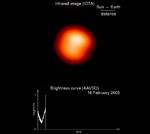Image List
-

This movie combines infrared images of the surface of Chi Cygni, obtained with IOTA, with visual brightness measurements provided by the American Association of Variable Star Observers (AAVSO). Chi Cygni demonstrates a 408-day-period of expanding and dimming, followed bycontracting and brightening.
Sylvestre Lacour, Observatoire de Paris -

Chi Cygni, a red giant star as shown in this artist's conception of Betelgeuse, is nearing the end of its life. As it runs out of fuel, it pulses in and out, beating like a giant heart and ejecting shells of material. Observations by the Infrared Optical Telescope Array found that, at minimum radius, Chi Cygni shows marked inhomogeneities due to roiling "hotspots" on its surface.
ESO/L. Calçada -

Chi Cygni changes brightness dramatically and regularly every 408 days due to in-and-out pulsations. Using interferometry to image the star's surface at four separate times, astronomers found that the star grows to a diameter of 480 million miles - large enough to engulf the asteroid belt - before shrinking to a minimum diameter of 300 million miles. Chi Cygni also shows significant hotspots near minimum radius.
Sylvestre Lacour, Observatoire de Paris -

Interferometric observations by SAO's Infrared Optical Telescope Array (IOTA), shown here, demonstrated that the red giant star Chi Cygni spans at least 300 million miles, large enough to swallow the planet Mars if it were at the center of our solar system. Interferometry combines signals from several telescopes to yield a sharp resolution equivalent to a single, giant telescope.
Peter Schuller, Smithsonian Astrophysical Observatory